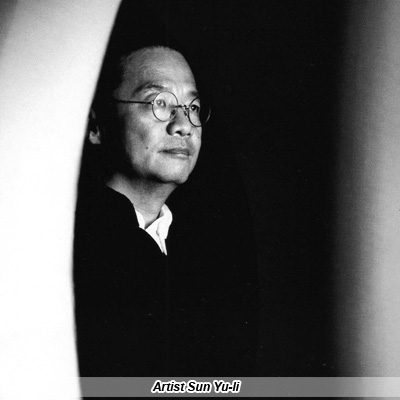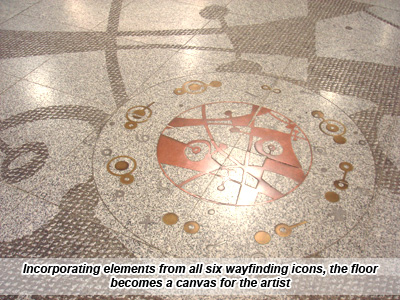|

Dhoby Ghaut station

An interchange station linking the North East Line to the North South
Line and the future Circle Line, Dhoby Ghaut is the
largest
station complex in Singapore. Dhoby
Ghaut is also the only station to have travellators, and these are found along the 80-metre underpass linking the North East line and the existing North South
Line.
Extending 30 metres below ground level, the centrally-located Dhoby Ghaut station is the
deepest station along the North East
Line. Construction work on Dhoby
Ghaut station included the re-routing of Stamford Canal that now sits on top of the second level of the station, covered up
by
the new pedestrian mall.
At the station, the two-tower Atrium@Orchard is the first commercial development in Singapore to be fully integrated with an MRT
station. The benefits of building
directly above a station are obvious as it optimises land use, and increases the convenience and accessibility of public
transport.
Back To Top
Embracing the spirit of art in architecture, architect turned artist Sun Yu-li has created
artworks that respond to the size and
complex layout at Dhoby Ghaut
interchange. The artist's works, which line the routes leading into the station, can be enjoyed for their artistic merit while
serving as directional signs for
commuters.
Sun Yu-li's works comprises 180 individual pieces featuring motifs sand-blasted on floor
tiles. These works are spread throughout
the six routes into the station. To
celebrate the arrival of commuters at the heart of the station, the artist has created a vibrant floor mosaic at Basement 2. This
floor mosaic is paired with a stunning
glass mosaic wall mural. As a finishing touch, the artist has also created 14 glass plates placed at strategic columns along the
entrance routes.

Back To Top
The challenge for the artist was to work with the layout of the interchange to help
commuters find their bearings. But the artist
also wanted commuters to enjoy his
art, and to exult in its colours, shapes and textures. The question was finding a central theme around which to build his art
concept. Ideally, the artist also wanted
commuters to get a sense of Dhoby Ghaut, its history
and its surroundings as they journeyed through the station.
The artist's final concept harks back to a passion he has nurtured for 25 years - the idea of
using his universal language of meta-
patterns, signs and messages that
has its root in the art of all early civilisations.

Back To Top
His visual language is made up of his universal language of dots, lines and planes blending
with icons commonly used in
prehistoric art - such as the hunter, the
dancer, the rider, the animal, the fish and the bird. By placing these different symbols along different routes, Sun Yu-li's work
helps commuters find their way by
associating each route with a particular symbol.
While the floor murals and mounted art pieces are a vibrant kaleidoscope of colour, the
icons like the hunter and dancer are
sandblasted onto the floor
tiles.

The sense of hidden treasures that await the initiated among commuters goes beyond the
floor tiles. The artist hopes that people
will realise that there is a subtle art
scheme in place, making every train ride a joyful thing.
Artist:
Sun Yu-li
Born: Nanjing, China, 1948
Education:
- Bachelor of Architecture, 1970
Tung Hai University, Taiwan, China
- Master of Urban Planning, 1973
University of Illinois, USA
- Master of Architecture, 1974
Catholic University of America, USA
Back To Top
The Land Transport Authority's (LTA) decision to incorporate integrated art in its stations called for artists to understand the
materials commonly used as building
finishes. In husband and wife team Milenko and Delia Prvacki, who work in mosaic and ceramics, the LTA found a creative duo whose medium of choice was ideally
suited to the marriage of art and architecture.
The Prvackis' work, which is located in the transfer level of the Dhoby Ghaut interchange,
comprise a bold floor mosaic at the foot
of five sets of escalators, a wall
mural combining Milenko's mosaics and Delia's ceramics and four sets of pillar rings.
The floor murals, which seem to form a fan-shaped carpet around the escalators, are
especially dramatic. Commuters can feast
their eyes on the texture and colours
of the mosaics before turning their attention to the quieter spaces and varied rhythms of the Prvackis' wall murals.

Back To Top
The husband and wife team had considered several factors before starting work. Firstly
and most importantly, the architecture of
the space of its function as an MRT
interchange. Then the cultural history of Singapore and lastly how they could work with the historical and cultural influences to
create contemporary art expressed in
a marriage of languages - mosaic and ceramics.
While some of the other artworks on the North East Line were fabricated by contractors, most of Milenko's and Delia's work was
realised by hand. Delia's touch
certainly made a difference in her works, which are so rich and tactile that they seem to invite commuters to touch them.

Back To Top
Milenko's portion of the combined artworks is made up of 22 wall panels, four column rings
and a large floor mosaic. These works
are made up of thousands of tiny
mosaic tiles, each one requiring the full attention of the artist. It was so difficult to complete the task that Milenko had to spend
three days a week for a whole year at
the Poh Cheong Concrete Product factory in Sungei Kadut where the mosaics were assembled.

To reinforce the fusion of their works, the artists constantly but discreetly employ elements
of each other's medium in their works.
Delia's porcelains and ceramics
have been integrated in Milenko's works, while bits of Milenko's mosaics are found among the intricate spirals and elliptical
shapes of Delia's ceramic tiles.

Back To Top
Milenko and Delia's work come together vividly on a combined wall mural overlooking
Milenko's floorworks on Basement 3. Both
extremes of the mural, one end in
mosaic and the other in ceramics, start off quietly. Delia's portion begins in blue and white porcelain and Milenko's in natural
stone.
Mosaic and ceramic intensify towards the centre of the mural, coming together in what
Delia calls "a dance of colours, textures,
lines, shapes and spirals." This visual
crescendo is eloquently expressed through the influence of Peranakan ceramics in Delia's work and the richness of Balinese
textiles on Milenko's.

Looking back over his experience at Dhoby Ghaut, Milenko feels that the whole experience
was more than just giving, but a
learning process as well.
Artist:
Milenko Prvacki
Born: Yugoslavia, 1951
Education:
- Master of Fine Arts (Painting), 1975
Institute of Fine Arts, Bucharest, Romania
Artist:
Delia Prvacki
Born: Romania, 1950
Education:
- Master of Fine Arts (Ceramics), 1975
Institute of Fine Arts, Bucharest, Romania
next: Little India station
Back To Top
|